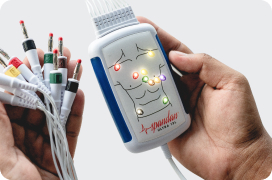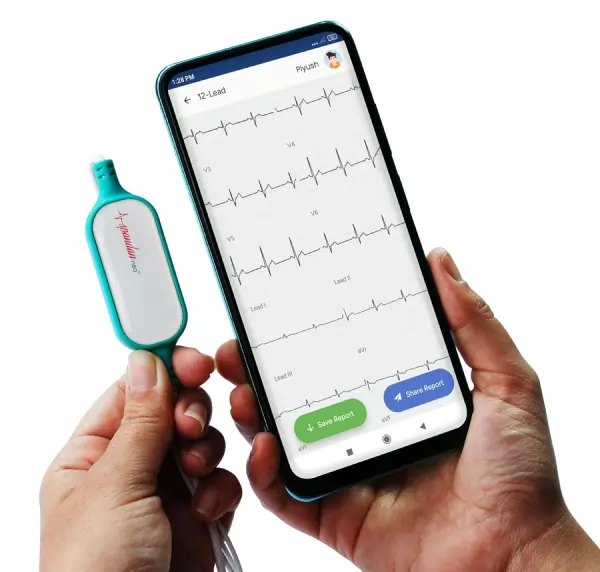
Author:- Dr Mansi
Table of Contents
Today, we are diving into the topic of Normal Fetal Heart Rate, a crucial aspect of prenatal care. Understanding what constitutes a healthy heart rate can provide valuable insights into your baby’s well-being and development. In this post, we’ll explore what a Normal Fetal Heart Rate looks like, why it’s important, and what deviations might signify.
Whether you’re expecting or just curious about prenatal health, this guide will help you decode the rhythm of your baby’s heartbeat and what it means for their overall health. Let’s jump in and uncover the details!
What is Fetal Heart Rate Monitoring?
Before going into the topic of Normal Fetal Heart Rate, we must first understand how the monitoring is done. The monitoring is done by a Fetal Heart Rate Monitor and is often used for measuring the rhythm and heart rate of your baby. This lets your healthcare provider see how your baby is doing. Fetal heart rate monitoring is crucial for assessing the health of a developing baby during pregnancy and labor, and it can be performed using either external or internal methods.
Types of Fetal heart rate monitoring
Fetal heart rate monitoring is crucial for assessing the health of a developing baby during pregnancy and labor, and it can be performed using either external or internal methods. Both methods help identify potential issues, ensuring timely medical intervention to support the fetal well-being.
External fetal heart rate monitoring
Sensors are affixed to the mother’s abdomen in order to do external fetal heart rate monitoring. Without the need for internal devices, these sensors use ultrasound technology to measure uterine contractions and identify the fetal heartbeat. Through the use of continuous, real-time data provided by this non-invasive technology, healthcare providers can monitor the baby’s heart rate and general health throughout labor. Its simplicity and ease of usage make it widely used.
- Ultrasound Transducer: The ultrasound transducer is a device that uses high-frequency sound waves to measure the heart rate of a fetus. It picks up the echoes of these sound waves as they echo off the unborn heart and is usually fastened to the mother’s belly with a belt or adhesive. This method provides a continuous and accurate reading of the fetal heartbeat and keeps a real-time check on the baby’s health.
- Doppler Ultrasound: Doppler ultrasound, is a portable instrument that generates ultrasound waves to identify the fetal heart rate. In order to determine the fetal heart rate, the Doppler device can measure the change in frequency of sound waves as they reflect off moving blood cells. Commonly used in routine prenatal appointments for quick evaluations, this device can be conveniently moved around the mother’s abdomen to detect the baby’s heartbeat.
Internal Fetal Heart Rate Monitoring
Internal fetal heart rate monitoring uses a fetal scalp electrode (FSE), a small and thin electrode that is directly connected to the baby’s scalp via the cervix. This approach offers an accurate assessment of the fetal heart rate by establishing direct contact with the infant’s skin. This technique is commonly employed when external approaches are insufficient or when more in-depth investigation is required, Although providing precise and uninterrupted data, this method necessitates the rupture of the mother’s membranes and is typically employed in more complex or closely monitored labor situations.
Understanding Normal Fetal Heart Rate
The normal fetal heart rate during the first trimester of pregnancy often falls within the range of 110 to 160 beats per minute (bpm). Given below is a summary of typical ranges of fetal heart rate throughout pregnancy:
- Weeks 5 to 7:About the fifth week of pregnancy is when a baby’s heart begins to form. The heart rate begins slowly in this early period (between 90 and 110 BPM).
- Week 8 to 12:By the ninth week, the heart rate increases and averages between 140 and 170 beats per minute. By the 12th week, the rate slows down slightly.
- Week 13 to 26: A fetus’s heart rate should typically range from 110 to 160 beats per minute (BPM) between weeks 13 to 26 of pregnancy.
- Week 27 to 40: Fetal heart rate averages between 110 and 160 beats per minute throughout the final trimester. In the final ten weeks, it does, however, somewhat decline. As the due date approaches, it often moves toward the lower end of this range.
What Is an Abnormal Fetal Heart Rate?
An abnormal fetal heart rate indicates a deviation from the typical range, either too fast or too slow. Such irregularities can signal potential issues that may require prompt medical attention.
- Fetal Bradycardia: A fetal heart rate that is continuously less than 110 beats per minute (bpm) is known as fetal bradycardia. This situation may indicate possible complications such as placental abnormalities, inadequate oxygen flow to the developing baby, or compression of the umbilical cord. In order to identify the cause of bradycardia, quick examination is essential upon detection.
- Fetal Tachycardia: It is used to describe a fetal heart rate that is continuously higher than 160 beats per minute. Fetal distress, dehydration, and/or maternal fever are some of the possible causes of this. When fetal tachycardia is noticed, the underlying cause needs to be determined through additional research. Treatment for any conditions the mother may have, hydration, or extra observation to make sure the mother and child are doing well are examples of interventions.
Need for Fetal Heart Rate Monitoring
Fetal heart rate monitoring is crucial for evaluating the health and well-being of the baby during pregnancy and labor. A normal fetal heart rate indicates that the baby is receiving adequate oxygen and nutrients. Monitoring helps detect potential complications early, such as umbilical cord compression or placental insufficiency, allowing for timely intervention. During labor, continuous monitoring of the fetal heart rate assists in guiding labor management decisions, ensuring both maternal and fetal safety. By providing real-time data, fetal heart rate monitoring plays a key role in enhancing prenatal and delivery care.
In conclusion, understanding the Normal Fetal Heart Rate is essential for ensuring the health and well-being of your baby throughout pregnancy and labor. Regular fetal heart rate monitoring provides critical insights into how well your baby is doing, helping to identify any potential issues early. By recognizing the typical ranges and deviations, such as bradycardia or tachycardia, healthcare providers can take timely actions to address any concerns and ensure both maternal and fetal safety.












